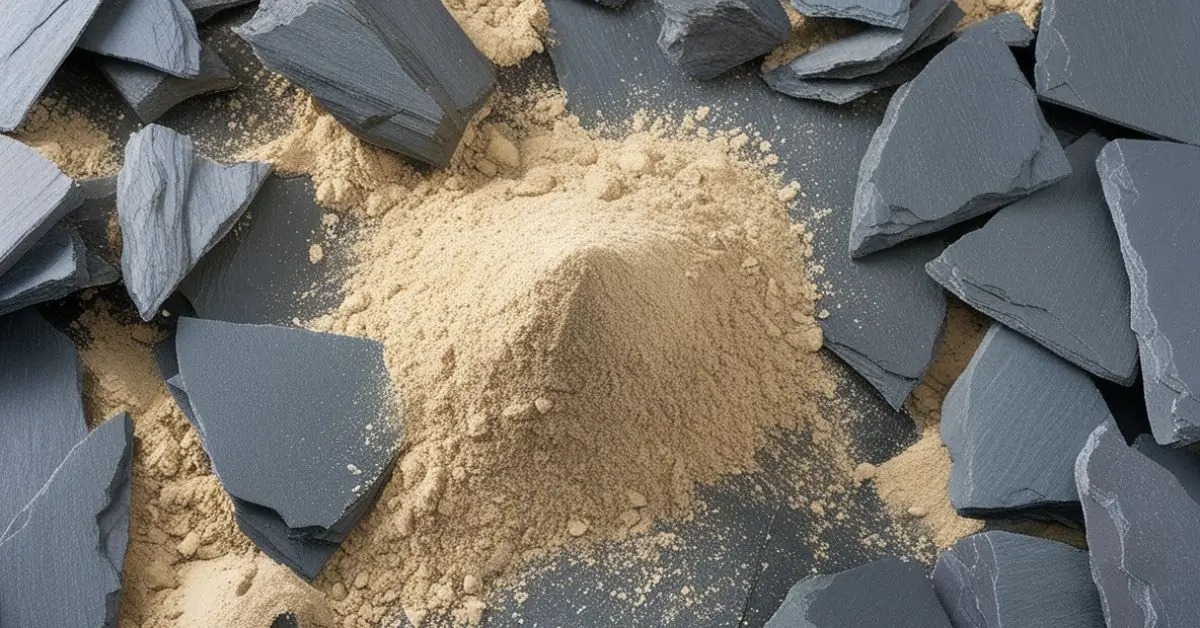Slate ash is a byproduct derived from the processing of slate, a fine-grained, foliated metamorphic rock commonly used in construction and roofing materials. Known for its durability and distinct, visually appealing textures, slate has been used for centuries in architecture and industry. However, the production of slate also results in waste materials, including slate ash. Over time, slate ash has found applications across various industries, from construction to environmental management, owing to its unique properties.
In this article, we delve into the composition, applications, environmental impact, and sustainable management practices surrounding slate ash, underscoring its relevance in today’s industries.
What is Slate Ash?
Slate ash is the residual powder left after processing slate rock. It forms as a fine particulate waste, typically generated during the crushing and breaking of slate slabs or during combustion if the material is used in industrial processes involving heat. While once viewed as a waste byproduct, slate ash has gained attention for its versatility, offering benefits that range from construction material enhancement to environmental remediation.
The color and characteristics of slate ash can vary based on its origin, often appearing in shades of gray to black. With growing environmental concerns about waste and resource management, industries are increasingly interested in transforming slate ash from waste into a useful resource.
Composition of Slate Ash
Understanding the composition of slate ash is essential to harnessing its potential. Slate itself is rich in minerals, including quartz, chlorite, and muscovite, along with traces of other elements like iron, calcium, and magnesium. These elements, when processed, contribute to the unique makeup of slate ash.
- Silicates: A primary component of slate, silicates contribute to the stability and chemical resistance of slate ash. They are also responsible for its fine, powdery texture.
- Iron Oxides: Iron is often present in slate in small amounts, lending a slight reddish or dark hue to slate ash. In certain applications, iron oxide in slate ash can contribute to color and thermal properties.
- Calcium and Magnesium: These alkaline earth metals help in soil conditioning and pH stabilization, especially in agricultural or environmental remediation uses.
- Trace Minerals: Slate ash may contain other trace minerals, depending on its geological origin. These could include potassium, sodium, and even rare minerals, each contributing to its various potential uses.
The variability in its composition makes slate ash suitable for multiple applications, with specific mixes of these elements enhancing particular characteristics depending on the intended application.
Applications of Slate Ash
The unique properties of slate ash, such as its fine texture, durability, and mineral content, have led to a growing number of practical applications. Let’s explore some of the most notable uses across industries:
1. Construction Industry
Slate ash is increasingly being utilized as a component in construction materials, especially due to its potential to reduce the environmental footprint of traditional materials.
- Concrete Additive: When mixed with concrete, slate ash can improve compressive strength and increase the durability of the final product. Its fine texture allows for better bonding and filling in small gaps within concrete structures.
- Bricks and Paving Stones: Slate ash can be incorporated into the production of bricks, tiles, and paving stones. It adds stability and resilience to these materials, making them ideal for long-term use.
- Roofing and Wall Panels: The fine particulate nature of slate ash, combined with its mineral stability, can be leveraged to create durable roofing and wall panel materials, enhancing weather resistance.
2. Environmental Applications
Slate ash also offers several environmental benefits, particularly in soil stabilization and filtration processes.
- Soil Stabilization: The mineral composition of slate ash can help adjust soil pH and improve soil quality. This application is particularly valuable in areas where soil acidity poses challenges for plant growth and agriculture.
- Water Filtration: The porous and stable structure of slate ash makes it suitable for filtering contaminants from water. It is used in specific filtration systems to remove heavy metals, particulates, and other impurities.
- Remediation of Contaminated Sites: Due to its ability to neutralize certain acidic contaminants, slate ash has potential as an agent in environmental remediation, particularly in regions affected by mining or heavy industrial activities.
3. Industrial Uses
In the manufacturing sector, slate ash is a valuable ingredient, especially in processes that require fine, heat-resistant materials.
- Ceramics and Glass Production: The silicate-rich composition of slate ash makes it ideal for use in ceramics and glass production, where it contributes to a smoother texture and heat resilience.
- Paints and Coatings: Slate ash can serve as a filler or pigment in paints, particularly for providing darker, natural tones. Its chemical stability also makes it suitable for weather-resistant coatings.
- Asphalt and Road Materials: In road construction, slate ash has shown to enhance the longevity of asphalt, offering a sustainable alternative to other mineral fillers.
Environmental and Health Impacts
The benefits of slate ash are undeniable, but it is essential to consider its environmental and health implications, especially when handling and disposing of it.
Environmental Impact
Improper disposal of slate ash can lead to soil and water contamination, primarily because it contains trace amounts of metals that can leach into ecosystems. However, when properly managed, these risks are minimized, and the material’s inherent stability can actually support environmental initiatives.
- Soil Contamination: If not processed or stored correctly, slate ash can alter soil composition, potentially harming plant life and soil health.
- Water Quality: Leaching from slate ash deposits into nearby water bodies can introduce minerals and potentially toxic elements, which may affect aquatic life and potable water sources.
Health Concerns
Slate ash is generally safe, but its fine, powdery nature requires careful handling to avoid respiratory issues associated with inhaling fine particles.
- Respiratory Risks: Prolonged inhalation of fine particles, such as those in slate ash, may pose risks of respiratory irritation or long-term respiratory conditions.
- Skin and Eye Irritation: Direct contact with slate ash can sometimes cause mild skin and eye irritation. It is advisable to wear protective gear when handling this material.
Proper safety measures, including wearing masks and gloves and implementing dust suppression techniques, help mitigate these risks.
Sustainable Management of Slate Ash
With a growing emphasis on sustainable practices, industries are exploring ways to recycle and reuse slate ash to minimize its environmental impact.
Recycling and Reuse
One of the most effective ways to manage slate ash sustainably is through recycling and reuse. By incorporating slate ash into products like concrete, bricks, and ceramics, industries reduce waste and decrease the demand for virgin raw materials.
- Product Innovation: Innovative research is continuously uncovering new applications for slate ash, such as eco-friendly building materials, which support circular economy practices.
Safe Disposal
When recycling and reuse are not feasible, safe disposal practices become essential. Slate ash should be disposed of in designated landfills or containment areas to prevent leaching into the environment.
- Containment Practices: Containment of slate ash can involve sealing it within impermeable barriers or adding stabilizing agents to reduce its mobility in the soil.
Future Trends and Innovations
The future of slate ash management is promising, with ongoing research focused on expanding its applications and reducing its environmental footprint.
- Eco-friendly Building Materials: Researchers are exploring ways to incorporate slate ash into low-carbon building materials, such as green cement and lightweight bricks.
- Carbon Capture Potential: Preliminary studies suggest that the mineral composition of slate ash could play a role in carbon capture, helping to sequester CO₂ and mitigate climate change.
- Advancements in Filtration: Further developments in water filtration technology could lead to more effective ways of utilizing slate ash for treating contaminated water.
These innovations are not only expanding the usefulness of slate ash but are also creating pathways for a more sustainable industrial future.
Conclusion
Slate ash, once considered an industrial byproduct with limited value, is proving to be an incredibly versatile and sustainable resource. From strengthening construction materials to aiding in environmental remediation, its applications are diverse and impactful. However, managing slate ash responsibly is essential to prevent environmental and health risks associated with its improper handling. By embracing recycling, safe disposal practices, and innovative research, industries can harness the potential of slate ash in ways that benefit both the economy and the environment.
In a world increasingly focused on sustainability, the journey of slate ash from waste to resource exemplifies how industrial byproducts can be transformed into valuable assets, contributing to a cleaner, greener future.











